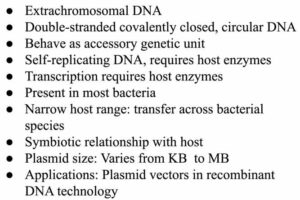![]()

- The term “Plasmid” was first coined by Joshua Lederberg in 1952 (Lederberg, 1952).
- Plasmids are extrachromosomal, double-stranded DNA molecules that are typically covalently closed and circular in structure. While most plasmids are found in this closed circular form, linear plasmids have also been documented in various organisms. Their size varies a lot, ranging from kilobases to megabases.
- Plasmids have been predominantly isolated from a wide variety of bacteria, including both gram-positive and gram-negative species. They behave as an accessory genetic unit and have the ability to inherit independently of chromosomal DNA. Some other organisms such as yeast and certain fungi also contain plasmids.
- Plasmids are capable of autonomous replication and contain the basic machinery needed to regulate their own replication; however, they depend on host proteins and enzymes for DNA synthesis.
- Although plasmids are not essential for the survival of bacteria, they contribute by providing some functions (plasmid-encoded traits) that can be advantageous to the host cell in certain circumstances such as in presence of antibiotics or bacteriophage attack. Based on their functions, plasmids can be divided into several categories, including conjugative plasmids (which facilitate bacterial conjugation), resistance plasmids (which carry antibiotic resistance genes), and virulence plasmids (which enhance pathogenicity).
- Plasmids carry genes that encode proteins essential for various traits, including resistance to antibiotics, heavy metals, and bacteriophages. These plasmid genes rely on the host’s proteins for transcription. Most plasmids have a symbiotic relationship with their host.
- Plasmids can coexist with other plasmids in the same cell. For example, Borrelia burgdorferi has been reported to have at least 20 different plasmids.
- Most plasmids such as ColE1, pBR322, and pUC18 have a narrow host range, which means that they exist only in related bacterial species.
- Some plasmids are maintained stably in a host cell, while others can be lost during cell division, especially if they do not confer a selective advantage.
- Plasmids are essential tools in molecular biology and biotechnology, serving as vectors for gene expression studies, gene knockouts, cloning genes, producing recombinant proteins, and creating genetically modified organisms.

REFERENCES
- Lederberg, 1952. Cell genetics and hereditary symbiosis. Physiol Rev. 32(4), 403-30. PMID-13003535; Full-Text Links: physiology, nih.gov (Download PDF)
1 thought on “Plasmid”